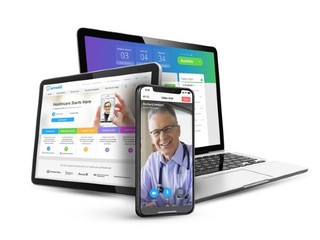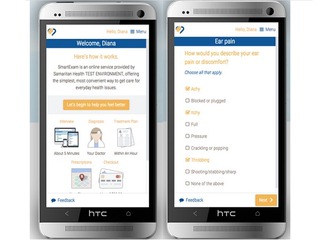Digital health funding declines for the third year in a row
AI-enabled digital health startups raised $3.7B, 37% of total funding for the sector
Read more...
Virtual care is all the rage right now, for obvious reasons, with patients, physicians and investors going all in, now that the prospect of in-office visits are either unavailable or unwanted due to COVID-19. There are a few problems with those solutions, though, specifically when it comes to video-focused solutions, according to Ray Costantini, M.D., co-founder and CEO of care-automation company Bright.md.
"Telehealth companies have sought to solve patient access problems by creating and using video technology that allows patients to seek care without coming into the clinic, while driving them away from higher-cost settings," he said, noting that they don't actually make life easier for patients or providers.
"In reality, these solutions don’t save providers time or alleviate any of the administrative burden they face. They change geography and nothing else. The adoption of video solutions has skyrocketed during the COVID-19 crisis, but many patients still lack broadband access or the technical knowledge to engage via video."
Meanwhile, other companies have tried asynchronous technology but those services "don’t address provider burden or workflow, efficiency, and capacity, and they haven’t enabled care-team transformation," he said.
What Bright.md offers is an AI-powered platform called SmartExam, which acts as a virtual physician assistant, enabling the physician to deliver efficient care remotely in a fraction of the time by asking patients questions about their symptoms and health history.
On Wednesday the Portland, Oregon-based Bright.md, which was founded in 2014, announced that it raised an oversubscribed $16.7 million Series C funding co-led by B Capital, Seven Peaks Ventures and Concord Health Partners, along with Philips Health Technology Ventures, UnityPoint Health Ventures and Concord Health Partners. With this latest round, Bright.md has now raised a total of $29.2 million.
The SmartExam can diagnose nearly 500 low acuity conditions, ranging from pink eye to low back pain to UTIs in less than two minutes. After an exam that typically ends within 10 minutes, patients then hear back from a provider with a diagnosis, treatment plan and after visit summary via email or text. Any prescriptions that the doctor prescribes are sent to the patient's pharmacy of choice. If needed, patients can also be routed to a video or in-person visit within their healthcare system.
For the physician, being able to use artificial intelligence to diagnose and treat a patient frees them up to spend more time with complex patients who need hands-on care. Bright.md also provides them with analytics to get a deeper view into what is and is not working, and which providers are most effectively using the platform.
"They can dive into which of their patient populations are using SmartExam, as well as those that aren’t so they can better tune their offers and promotion. They can examine how often clinicians are adhering to evidence-based practices around antibiotic stewardship, among other things. And they can track provider satisfaction to improve workflows and training," said Costantini.
"We work hand-in-hand with customers to build patient adoption. Marketing automation tools and expertise allow us to aid our customers in outreach efforts to continue to drive registrations and SmartExam usage."
Bright.md currently works with just over a dozen healthcare systems, many of which are umbrella organizations for multiple hospitals and care facilities. Its customers have reported that the SmartExam diagnosis was the correct one roughly 80 percent of the time, with adherence above 90 percent.
Along with SmartExam, Bright.md has launched some COVID-19 specific protocols since the beginning of the year, integrating coronavirus screening questions into its care platform in January, while also adding a free screening tool to hospitals in early March.
"With the free COVID-19 screener, health systems are only able to assess the risk level to either direct patients to the right venue for care or provide them with at-home care instructions specific to COVID-19 based on CDC guidelines. The COVID screener is free and can be deployed within two days. SmartExam takes up to two months to deploy," Costantini told me.
If a patient using the COVID-19 screener is determined to be at high-risk for infection, they are then directed to a higher modality of care, at which point the healthcare system will take over, with a provider, not Bright.md, deciding whether testing or further care is necessary.
Bright.md says will use the funds, in part to expand its technology, with a focus on new ways to increase access, convenience and use for patients and more efficient and improved care delivery quality for providers through care automation and greater interoperability.
"This will help address what we’re seeing today related to the exposure in gaps that exist in public health, clinical capacity, emergency situations, shifting business landscapes, and stress put on frontline staff to help better equip healthcare systems in a post COVID-19 era," said Costantini.
"We are putting the money to work, expanding both our product and team so that we can continue to help create new and easier access for patients and unburden those who deliver their care from unnecessary administrative busywork."
The funding will also go toward expanding to new markets, now that "COVID-19 has rapidly changed the way care is accessed and delivered."
"We first focused our care automation platform on telehealth, helping to not simply change geography, but to use technology to automate the non-value added things that patients, providers, and even administrative bureaucracy does in order to deliver a complete episode of care. We can apply our care automation much more broadly than to simply making telehealth better. It can make all sorts of care episodes better for everyone involved," Costantini explained.
"Of course, as the company has grown and evolved, we have added care for scores of new conditions and we will continue to do that as well."
Thanks to COVID, Bright.md has seen more patients in the first three months of 2020 and than all of 2019. It has experienced greater than 1,200 percent growth in patient visits when comparing April 2020 to April 2019 and it has recently seen more than a 2,000 percent increase in net new patients using SmartExam. Many other companies have reported similar increases in telehealth adoption over the last few month, though the number of people accessing these services has already begun to dip a bit in recent weeks as in-office visits pick back up.
When it comes to the question of whether telehealth is a temporary phenomenon or not, Costantini's view is clear: "The telehealth genie is indeed out of the bottle," he said, noting that it might take years for people to feel fully comfortable going to see a doctor in person again.
"While the COVID-19 pandemic has shined a spotlight on the need for vibrant telehealth offerings, it has also exposed the limitations associated with video-only solutions," he said.
"Though video has enabled patients and providers to continue care, video visits still require a scheduled appointment with a doctor, take weeks of provider training to become proficient, and take the same amount of physician time as in-person visits. Providers need to offer a virtual entrypoint to care, like Bright.md’s SmartExam, which streamlines care delivery across the entire care continuum."
AI-enabled digital health startups raised $3.7B, 37% of total funding for the sector
Read more...OXcan combines proteomics and artificial intelligence for early detection
Read more...Nearly $265B in claims are denied every year because of the way they're coded
Read more...Startup/Business
Joined Vator on
Bright.md licenses a software platform to primary care groups, automating up to 90% of provider time spent on the low-acuity conditions, such as colds, flus and earaches, that make up more than half of their visit volume. We do this through online exams, conveniently accessible from patient's home or mobile device. This approach expands medical group capacity by 30%, reduces incremental visit costs by 80%, and opens new revenue opportunities.

Joined Vator on

